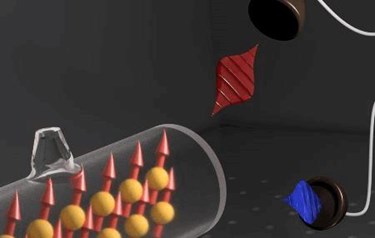Physicists Entangle Single Photon With A Trillion Rubidium Atoms
By Jof Enriquez,
Follow me on Twitter @jofenriq

Scientists at the Quantum Memories Laboratory at the University of Warsaw have demonstrated multidimensional entanglement of a group of about one trillion atoms and a single photon. The entangled state allows enhanced storage of quantum memory and faster quantum information processing.
Entanglement in quantum physics is the ability of two or more particles to be correlated beyond what is possible, or explained, in classical physics. Particle entanglement allows vast amounts of information to be stored in qubits used by quantum computers. However, entanglement becomes a challenge to create when many macroscopic particles are involved.
Physicists at the University of Warsaw are the first to demonstrate such a feat in an experimental setup wherein a laser beam with single photons is beamed through a quantum memory glass cell containing about one trillion atoms. Because they subsequently end up in an entangled state, a single photon – whose position and momentum are measured by a sensitive camera – is able to carry information about the quantum state of the entire group of atoms. This is confirmed through the detection of the camera by a second photon.
“We demonstrate the Einstein-Podolsky-Rosen apparent paradox in a very similar version as originally proposed in 1935, however we extend the experiment by adding storage of light within the large group of atoms. Atoms store the photon in a form of a wave made of atomic spins, containing one trillion atoms. Such a state is very robust against loss of single atoms, as information is spread across so many particles” says Michal Parniak, a PhD student taking part in the study, published in the journal Optica.
The Polish researchers’ experiment was unique because the quantum memory storing the entangled state stored up to 12 photons at once, and showed an unprecedented delay time of 6 μs between generation of entanglement and detection of the atomic state. This implies much faster quantum information processing than previous experiments have demonstrated.
“The multidimensional entanglement is stored in our device for several microseconds, which is roughly a thousand times longer than in any previous experiments, and at the same time long enough to perform subtle quantum operations on the atomic state during storage,” explains Dr. Wojciech Wasilewski, group leader of the Quantum Memories Laboratory team.
This type of entanglement can be combined with other multiple degrees of freedom, such as polarization, spatial mode, and orbital angular momentum, allowing generation of so-called hyperentanglement – a promising resource in quantum information processing.
